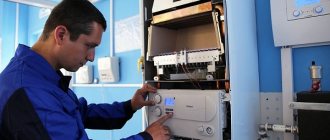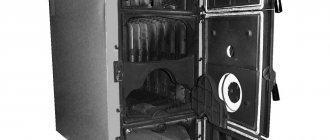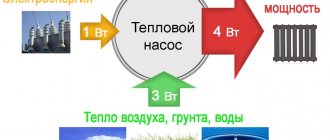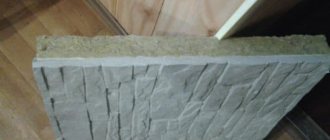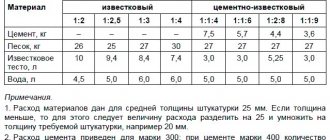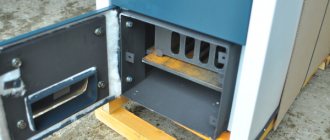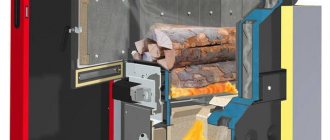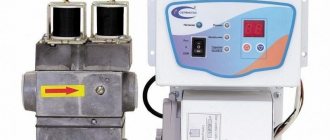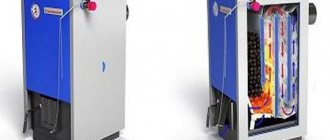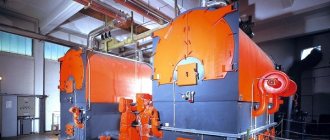If you are planning to build a country house in a place where there is no possibility of connecting to centralized heating, you will definitely be faced with the question of choosing an autonomous heating system. Quite often in such cases you have to be content with installing a solid fuel boiler that uses the energy of wood or coal in its operation. The modern market offers many solutions; manufacturers promise high heat transfer and efficiency, as well as low fuel consumption. But should we trust the promises of manufacturers? This article will help you understand the issue of selecting the power of solid fuel boilers and their efficiency. It will help you find out the nuances of the operation of a solid fuel boiler and how effective it is.
Efficiency of a solid fuel boiler
The power of the solid fuel boiler of the heating system, and therefore the ability to heat the room, is of course an important parameter, but not so much as to put it at the forefront. You also need to pay attention to how much fuel it consumes for this. The ratio of these costs to the amount of useful heat released by the boiler to heat the house is called the efficiency factor, or efficiency for short.
What determines the efficiency of a solid fuel boiler (and, accordingly, power)? First of all, from the loss of useful heat, which can occur due to underburning of gases released during combustion (due to which, by the way, soot is formed), the quality characteristics of the fuel and the degree of heat energy released into the chimney. These and other factors that reduce efficiency will be discussed below.
Operating rules for boiler devices, compliance with which affects the efficiency value
Any type of heating unit has its own optimal load parameters, which should be as useful as possible from a technological and economic point of view. The operation process of solid fuel boilers is designed in such a way that most of the time the equipment operates in optimal mode. This operation can be ensured by following the rules of operation of heating equipment operating on solid fuel. In this case, you must adhere to and follow the following points:
- it is necessary to observe acceptable modes of blowing and exhaust operation;
- constant control over the intensity of combustion and completeness of fuel combustion;
- control the amount of entrainment and failure;
- assessment of the condition of surfaces heated during fuel combustion;
- regular boiler cleaning.
The listed points are the necessary minimum that must be adhered to during the operation of boiler equipment during the heating season. Compliance with simple and understandable rules will allow you to obtain the efficiency of an autonomous boiler stated in the characteristics and improve the operation of a solid fuel boiler.
We can say that every little thing, every element of the design of a heating device affects the value of the efficiency factor. A properly designed chimney and ventilation system ensure optimal air flow into the combustion chamber, which significantly affects the quality of combustion of the fuel product. Ventilation performance is assessed by the excess air coefficient. An excessive increase in the volume of incoming air leads to excessive fuel consumption. Heat leaves more intensely through the pipe along with combustion products. When the coefficient decreases, the operation of boilers deteriorates significantly, and there is a high probability of oxygen-limited zones appearing in the furnace. In this situation, soot begins to form and accumulate in large quantities in the firebox.
The intensity and quality of combustion in solid fuel boilers require constant monitoring. The combustion chamber must be loaded evenly, avoiding focal fires.
Note: coal or firewood is evenly distributed over the grates or grate. Combustion should occur over the entire surface of the layer. Evenly distributed fuel dries quickly and burns over the entire surface, ensuring complete burnout of the solid components of the fuel mass to volatile combustion products. If you have correctly placed fuel in the firebox, the flame when the boilers are operating will be bright yellow, straw-colored.
During combustion, it is important to prevent failure of the fuel resource, otherwise you will have to face significant mechanical losses (underburning) of fuel. If you do not control the position of the fuel in the firebox, large fragments of coal or firewood falling into the ash box can lead to unauthorized combustion of the remaining fuel mass products.
Soot and resin accumulated on the surface of the heat exchanger reduce the degree of heating of the heat exchanger. As a result of all of the above violations of operating conditions, the useful volume of thermal energy required for the normal operation of the heating system decreases. As a result, we can talk about a sharp decrease in the efficiency of heating boilers.
Why you shouldn't trust advertising
When viewing advertisements related to the power of solid fuel boilers, you can often see offers promising 90% efficiency and higher. However, if you request any official protocol or act confirming this indicator, they will not be able to provide it to you, and here’s why.
To draw up such a document, it is necessary to carry out tests using appropriately standardized fuel. In relation to coal or firewood, it is impossible to obtain such fuel - because they are the most unstable in the world by their characteristics and composition. How can you get a constant indicator using non-constant components?
Instability of solid fuels
Let's consider what is the instability of coal or wood as fuel. Let's start with coal.
There are countless different grades of coal offered on the market. Each brand differs in structure, chemical composition and moisture content. It can consist of both large pieces and small particles, and all of them can be mixed in different proportions. Accordingly, the calorific value of coal will be different each time. Accordingly, the efficiency and power of solid fuel coal will also be different.
If we talk about firewood, the situation here is exactly the same. Logs have different sizes, are stored at different air humidity, which means their ability to generate heat will be different. So, for example, if at a wood moisture content of 15%, its calorific value will be approximately 4.3 kWh per kilogram, then at 20% it will already be less than 4 kWh per kilogram. With higher humidity this figure will be even lower.
Naturally, with such variations, guaranteeing the exact efficiency and power of a solid fuel boiler equal to 90% is, to put it mildly, misleading.
Let's consider other factors influencing the efficiency indicator.
Double-furnace boilers
| Double-furnace boiler with horizontal combustion chambers |
In case of frequent fuel changes, it is more convenient to use double-furnace boilers. These units are larger in size than single-fire units; different types of fireboxes can be located one above the other or on the same horizontal line.
In this case, the same coolant circuit is heated by different types of fuel, and the transition is carried out without additional installation work, manually or automatically, depending on the additional equipment used.
Each of the fireboxes is designed for its own type of fuel and therefore combustion in them is more efficient, consumption is lower and there is no need to reconfigure the boiler every time the mode is changed.
There is usually only one smoke collector in such boilers. There are double-circuit boilers, and then different types of fuel can be heated separately - the heating circuit, and separately - the hot water supply, or, for example, the heated floor circuit due to multiple outlets from the boiler.
Combination boilers in conditions of unstable operation of electricity or gas supply networks, coupled with the availability of other resources such as firewood or diesel fuel, are very popular devices. They are heavy, require a good foundation, and are bulky, but they reduce the cost of purchasing several types of boilers and piping them. Competent consultants in boiler sales shops, by combining the type of boiler and additional equipment for it, can choose an economical option for the boiler room, allowing you not to worry about the cold in the house during any interruptions in fuel supply.
Incorrect air supply
The work of the flame greatly depends on how much oxygen enters the firebox. In order for fuel to burn normally and give off the maximum amount of heat, it needs a strictly defined amount of air - no more, no less. If there is not enough air, the hydrocarbons released during combustion will be poorly oxidized, which means less heat will be released. If a lot of air comes in, and it usually comes in cooled, the temperature of the released gases decreases and they do not have time to burn (again settling as soot on the pipes) and thereby release useful heat. It is worth noting that the air contains moisture, the evaporation of which also wastes heat (instead of heating the house).
Most solid fuel boilers offered on the market operate on the following principle. They have a thermostat installed that regulates the temperature of the water circulating through the heating system of the house to warm it. If the water becomes too hot, the thermostat reduces the air supply to the boiler (this is how the power of a solid fuel boiler is regulated). It turns out that at the moment when the fuel flared up and the efficiency with the power of the solid fuel boiler became maximum, which means the flame began to need more oxygen, the thermostat artificially reduces the efficiency, limiting the air supply.
After the temperature has dropped, the thermostat starts supplying air again. But by that time the fuel is already burning down and it doesn’t need as much oxygen. The heating efficiency is again reduced due to the cooling of the released gases, as mentioned earlier.
It turns out that the operating principle of most solid fuel boilers absolutely contradicts the concept of high efficiency.
24-hour loss of thermal energy
To maintain the required temperature in the house, the solid fuel boiler must operate 24 hours a day. Now imagine how much useful heat flies out into the chimney in the form of soot and unburned gases during this time? The efficiency of such work cannot be 90%.
Another type of boiler worth mentioning here is the pyrolysis boiler. In addition to the above disadvantages, two more are added in his case:
- A fan running 24/7 consumes electricity.
- Thanks to the same fan, excess oxygen enters the boiler - the temperature of the gases decreases, they do not have time to burn and fly away into the chimney.
The accelerated movement of gases through the pipe causes a decrease in another parameter - heat transfer efficiency. Due to the special design of the boiler, the flame in it does not have time to burn out and rises into the heat exchanger, where it dies out, leaving soot along the way and throwing unburned gases into the chimney.
Operating principle of coal boilers
Scheme of operation of a solid fuel boiler
A standard coal-fired boiler has the form of a solid body with lining. To reduce heat loss, a layer of heat-insulating material is used.
On the front there are three compartments with lids to prevent smoke from entering the room. The lower compartment is the ash pan. On the bottom rear panel there is an adjustable hole - it creates natural or forced draft. The central chamber is the firebox where coal is placed.
A grate is used to separate the lower and central compartments, create a direct flow of air masses and remove combustion products. During the combustion reaction, warm air flows through the pipes into the upper compartment and heats the heat exchanger. The heated water is sent through pipes for heating and to the hot water supply. Temperature parameters are selected by a chain regulator or an electronic mechanism.
Units with manual adjustment need to be turned on 4-6 times a day, so monitoring the temperature at night is problematic. Automatic boilers are equipped with an auxiliary fuel tank. One load of coal can work for up to a week. The temperature of the coolant does not change.
The need to constantly monitor the operation of the boiler
In conclusion, it is worth saying that the power of a solid fuel boiler must be monitored around the clock, 7 days a week. You won’t be able to leave normally, go somewhere and leave the boiler unattended. In fact, you become his hostage for all months of the heating season.
Whether it is worth installing such a boiler is of course up to you to decide. But it still makes sense to look for an option that is more efficient, economical and does not have such operating requirements.
How to increase the efficiency of a gas boiler
It is almost impossible to increase the efficiency of fuel combustion by interfering with the technical structure of the boiler; it will not be possible to install the same layer of thermal insulation due to the banal failure of the manufacturer to provide a place for it. In addition, doing this yourself is prohibited. Nevertheless, there are ways to increase the efficiency of a gas boiler, especially if it is an imperfect old-style model:
- Ready-made economizer for chimney – replaces a certain section of the chimney and is designed to accumulate heat from gases exhausted through the chimney (some kind of imitation of condensing boilers). However, it is necessary to accurately calculate the parameters of the economizer and the requirements for the chimney in order to maintain the necessary draft and prevent reverse draft, for example, in strong winds. The issue price is 1,700-2,500 rubles.
Sandwich mesh economizer for chimney pipe. - A homemade economizer is almost identical to the finished products described above. We have already described how to make an effective economizer in one of the previous articles.
- Cleaning the boiler and flushing the heat exchanger are regular maintenance measures that are meaningless for new boiler units, but extremely effective for those that have been in use for at least several seasons. The fact is that during operation, scale and other salt deposits form inside the heat exchanger, and the external fins of the heat exchanger, burners and igniter become clogged. All this leads to an increase in gas consumption, a decrease in heating output, and, accordingly, a decrease in efficiency (often up to 20-30%). We have also already discussed how and how often it is necessary to clean a gas boiler.
- Gas filter - it is installed in front of the shut-off valve of the gas main and is designed to clean the gas from debris and impurities that are sometimes found in the composition. This not only helps reduce soot formation, but also, by improving the quality of the fuel, slightly reduces heat loss during underburning.
